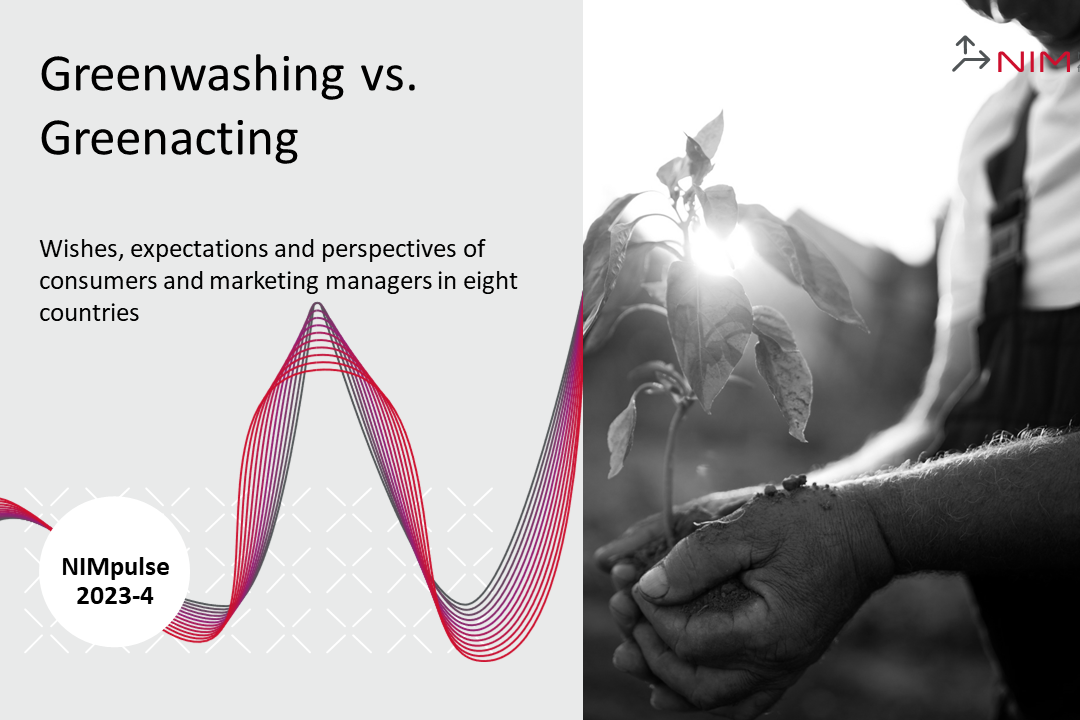Publikationen
Greenacting vs. Greenwashing NIM INSIGHTS Research Magazin VOL. 4
DownloadFifka, M. (2024). 50 Shades of Green(washing) — The Challenge of Communicating Sustainability Convincingly. NIM Insights Research Magazin VOL. 4, 12-17.
2024
50 Shades of Green(washing)
Due to the increasing importance of sustainability in corporate communication, having to face greenwashing accusations has become a widespread apprehension in marketing today. Increasing customer sensitivity, governmental regulation—with the EU Green Claims Directive on the horizon—and NGOs stepping up the blaming-and-shaming game have created an environment in which it is challenging to communicate convincingly.
Author: Prof. Dr. Matthias Fifka
Being accused of greenwashing is not a recent phenomenon. The term itself is commonly attributed to Jay Westerveld, an American environmental activist who attacked the American hotel industry for their “Save the Towel” campaign in 1986. Westerveld claimed that the call to their guests to reuse towels was not environmentally motivated but a simple maneuver to save money. Westerveld claimed that the hotel industry had not done anything to protect the environment before and basically was built on a business model doing substantial harm to the environment. Thus, their campaign was purely “cosmetic” from his point of view. Inherent in this argumentation are three challenges for companies wanting to communicate their environmental activities that we will address later on:
• Any communication of early-stage environmental activity could be regarded as greenwashing.
• Green communication by companies pertaining to an industry whose business model causes environmental damage (which applies to any industry to some degree) might inevitably be seen as greenwashing.
• Economic and ecological pursuits are mutually exclusive.
"Greenwashing lies in the eye of the beholder."
Seele and Gatti (2015: 239)
Just what is greenwashing?
As can be seen from Westerveld’s accusations, greenwashing is potentially broad in nature and is subject to two perspectives: the one of the company acting as a sender and the one of the consumer who receives the company’s message. From the company’s point of view, Baum (2012: 424) appropriately describes greenwashing as “the act of disseminating disinformation to consumers regarding the environmental practices of a company or the environmental benefits of a product or service.” Thus, greenwashing entails a purposeful attempt to mislead the customer about the environmental performance of a company or its products and services.
From the consumer’s perspective, greenwashing “lies in the eye of the beholder,” as Seele and Gatti (2015: 239) have observed. Simply said, what appears as greenwashing to one consumer might not be regarded as such by another. For the company communicating its environmental activities, this inevitably leads to the challenge that the line between communication perceived as authentic and communication perceived as misleading is blurred. Greenwashing as such is a phenomenon that comes in many shades.

The many shades of greenwashing
A first step in overcoming this challenge is to know what practices can easily be perceived as greenwashing and thus should be carefully considered. Or, seen from the other perspective, these are the practices that make companies vulnerable to attacks by NGOs, journalists, and consumers.
1.
Offering no proof: Not providing evidence for the claims you make is the safest road for companies to be accused of greenwashing—in particular, when numbers provided lack any basis for calculation or substantiated scientific evidence.
2.
Being vague: The attempt to appear green by sending vague messages might also seem an easy choice. Typical examples are claiming that the ingredients used are “natural” or the product is of “regional origin.” Crude oil also is a natural product, and Europe can also be seen as a region.
3.
Using meaningless labels: Closely related is the application of meaningless labels. Using a label that is easy to obtain (some can be purchased without meeting any requirements) or even designing your own label might be tempting. Keep in mind that “the other side” is now providing databases accessible for everyone to make detecting meaningless labels quite easy.
4.
Green overloading: Just like meaningless labels and terminology, using green colors paired with trees, happy animals, and clear lakes on your product might lead to suspicion that behind all the greens, you have something to hide.
5.
Emphasizing the irrelevant: At times, companies resort to pointing out product features that can be taken for granted, such as marking a product to be free of animal testing in a jurisdiction where animal testing is prohibited anyway. Unsurprisingly, emphasizing that you are acting within the limits of the law does not resonate well.
6.
Emphasizing the exception: This could also be referred to as “lighthouse projects.” A good example is a cruise ship company that made a big deal out of putting one ship running on natural gas into service, while the other 12 continued running on crude oil.
7.
Stressing the lesser of two evils: Emphasizing the good side of a product while hiding the much larger negative impacts is sometimes hard to detect for the consumer, but it is by no means “bulletproof.” Declaring that you have managed to reduce the energy consumption of a product by reducing its weight while hiding that the new material used to achieve this is not recyclable, or even hazardous waste, might backfire.
8.
Making diffuse promises: Promising to act green or to improve is not wrong by any means. But then the follow-up is essential. If you do not live up to your promises or wiggle out by claiming that the promise was meant differently, you will be regarded as a cheater.
Prevention against greenwashing accusations
After having looked at what you should not do, let us discuss what you should do in order to avoid accusations of greenwashing.
A good start is to match your existing or planned green communication with the list above, though it does not claim to be exhaustive. If you find an overlap, then you should reconsider what you are doing. Does that mean you should halt all your communications and only resume your marketing when you have become the greenest company on earth?
Definitely not. There is nothing wrong—unlike what Westerveld claimed—with communicating your first environmental activity ever. But then you should acknowledge that you have just started out, that this is your first step, and that you are aware that there is a long way to go. Being honest and authentic is the best way to prevent greenwashing accusations. Consumers do not expect you to be perfectly green instantly and will understand that it is a learning process. So take them along the way.
This also entails that you admit the shortcomings of your efforts. If the new material you are using is more environmentally friendly than the one before, but still not fully recyclable, admit it. In many cases, we do not have the perfect solutions yet and will need to develop new materials, technologies, processes, or even systems, such as the circular economy. You might argue that it is impossible to put all this on your product or its packaging unless you want to have it look like a dictionary. That is a point, but the respective information can be provided as a follow-up on your website, where there is plenty of space. And you can easily link to it by means of a QR code and thus refute any claims that you are trying to hide something.
“Being honest and authentic is the best way to prevent greenwashing accusations.”
Prof. Dr. Matthias Fiefka (2024)
Closely related is the ability to back up what you have claimed. Not being able to substantiate your efforts or performance makes you easily vulnerable to attacks. But if you can show how you calculated the emissions reductions you communicate, there is no ground for accusations—certainly implying that your numbers are substantial and your math is correct.
What about the confrontational argument that you are only in it for the money or do not really care about the environment and only do what you do to improve your image? The latter, in particular, is the end of all arguments, because it is hard, if not impossible, to dispel it. What could you argue? That you do not care about your balance sheet or reputation? That would probably be the least convincing counterargument of them all. Because, after all, you operate in a free market, where what you do has to pay off at least in the long run and that is hard to achieve if your image is ruined. Thus, if the new LED lighting system you have installed reduces not only energy usage and emissions but also your operating cost, there is nothing wrong with making that transparent. The accusation to have done it only for the money can still be made, but no one can accuse you of lacking transparency.
New regulation looming on the horizon
When you have taken care of all of the above, you essentially do not have to worry about new regulations looming on the horizon. In March 2023, the EU Commission published a proposal for a directive that aims at preventing companies from advertising themselves or their products or services as more environmentally friendly than they actually are by purposefully misleading consumers. The overriding goal of this so-called “Green Claims Directive” is to ensure transparency and give consumers the certainty that something that is advertised as being green actually is.
The directive seeks to prohibit making claims on environmental benefits that result from what is required by law anyway (see No. 5). Claims on benefits exceeding legal boundaries have to be substantiated by scientific evidence (No. 1). But that is not all. If positive environmental effects are advertised, they must not be outweighed by any negative side effects (No. 7). To provide such a full picture, the company has to make clear if the claim is related to the whole product or only a part of it, or to all or only certain activities of the trader. Labeling schemes are also targeted by the proposed directive. New private labeling schemes are only allowed if they provide added value in terms of their environmental ambition, compared with existing eco-label schemes, and are approved in advance. If developed and brought on the market, they need to contain transparent information about the issuer, the objectives, the requirements, and the procedures pertaining to the monitoring of compliance with the label in question.
Finally, all environmental claims and labels will have to be verified by an independent auditor directive stipulates. The directive will reduce environmental advertising substantially not only because of the limitations it places on green claims but also because of the costs resulting from the auditing process. How do you deal with that? You will have to make your green advertising more selective—unless you have coffers full of money—choosing key areas and products or services you bring to market. You will also have to implement the processes needed to generate the necessary scientific information or proof and have it audited. This implies entering into partnerships and developing the respective workflows, and most importantly, getting rid of unsubstantiated claims and happy pictures from la-la land that you might still be using in your communications. Though the directive will not come into force before 2026, most likely, the best time to get started is today because, in the meantime, NGOs, journalists, and consumers will take over.





